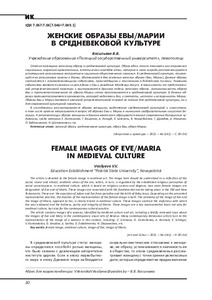Please use this identifier to cite or link to this item:
https://elib.psu.by/handle/123456789/28708Full metadata record
| DC Field | Value | Language |
|---|---|---|
| dc.contributor.author | Васильева, В. В. | - |
| dc.date.accessioned | 2022-01-19T12:24:36Z | - |
| dc.date.available | 2022-01-19T12:24:36Z | - |
| dc.date.issued | 2021 | - |
| dc.identifier.citation | Васильева, В. В. Женские образы Евы/Марии в средневековой культуре // Искусство и культура. – 2021. - №1 (41). – С. 30-34. | ru_RU |
| dc.identifier.uri | https://elib.psu.by/handle/123456789/28708 | - |
| dc.description.abstract | Статья посвящена женскому образу в средневековой культуре. Образ здесь стоит понимать как отражение социальных, морально-нравственных, эстетических взглядов эпохи, которые в свою очередь регламентируются устоявшимся религиозным восприятием социально-общественного сознания. В средневековой культуре, опирающейся на религиозные каноны и догмы, обозначаются два основных женских образа (Евы, Марии). Данные образы соотносятся с основополагающими событиями, происходящими и описанными в библейском писании. Таковыми событиями являются изгнание из рая Адама и Евы и рождение Младенца Иисуса. В зависимости от представленной репрезентативной практики и выстраивается дуализм подачи женского образа. Антиномичность образа Евы и противопоставленного ей образа Марии четко прослеживается в средневековой культуре. В данных образах противопоставляется греховность, которой наделялась Ева, и святость, чистота и непорочность Марии. Образы Евы и Марии являются ключевой репрезентативной основой не только для средневековой культуры, но и для современной культурной практики. В исследовании рассматриваются образы женщины, выделяемые средневековой культурой и искусством, в том числе кратко затрагивается вопрос об образах Евы и Марии в нынешнем изобразительном искусстве Беларуси. К репрезентации образа женщины в данном контексте обращаются многие современные белорусские художники, среди которых З. Литвинова, Г. Ващенко, А. Концуб, Е. Шлегель, В. Концедайлов, Г. Дроздов, А. Изоитко, О. Евдокименко, Н. Шоповалова и пр.= The article is devoted to the female image in medieval art. The image here should be understood as a reflection of the social, moral and ethical, aesthetic views of the era, which, in turn, is regulated by the established religious perception of social consciousness. In medieval culture, which is based on religious canons and dogmas, two main female images are designated: of Eve and of Maria. These images are associated with the fundamental events taking place in the Old and New Testaments. These are: the expulsion of Adam and Eve from paradise and the birth of Baby Jesus. Depending on the presented representative practice, the dualism of the representation of the female image is built. The antinomy of the image of Eve and the image of Maria, opposed to her, is clearly traced in medieval culture. These images contrast the sinfulness with which Eve was endowed and the holiness, purity and integrity of Maria. These images are a key representative basis not only for medieval culture, but also for the contemporary cultural practice. The article contains images of a woman, identified by medieval culture and art, including a briefly reviewed issue about the images of Eve and Mary in the contemporary visual arts of Belarus. Many contemporary Belarusian artists turn to the representation of the image of a woman in this context, including: Z. Litvinova, G. Vashchenko, A. Kontsub, E. Schlegel, V. Kontsedailov, G. Drozdov, A. Izoitko, O. Evdokimenko, N. Shopovalova, etc. | ru_RU |
| dc.language.iso | ru | ru_RU |
| dc.title | Женские образы Евы/Марии в средневековой культуре | ru_RU |
| dc.type | Article | ru_RU |
| dc.identifier.udc | 7.067:7.04[7.046+7.049.1] | - |
| Appears in Collections: | Публикации в зарубежных изданиях | |
Items in DSpace are protected by copyright, with all rights reserved, unless otherwise indicated.
